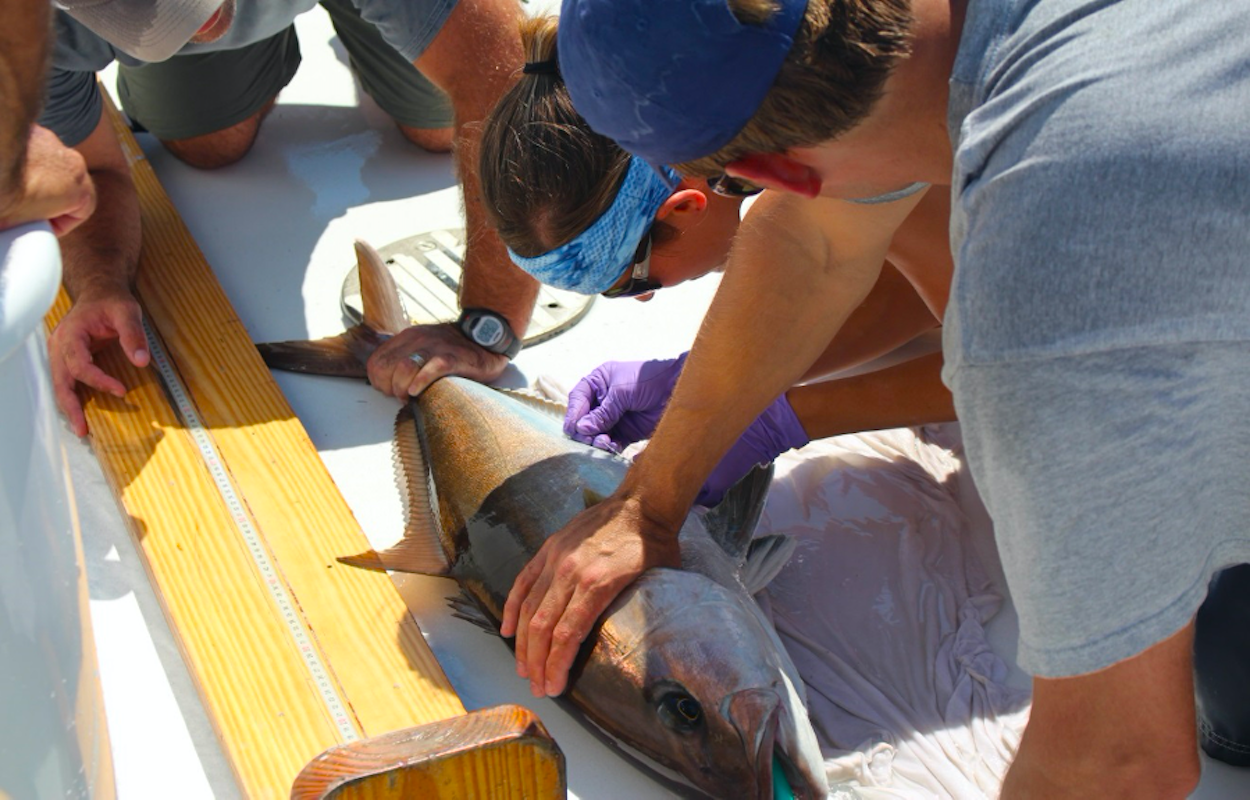Discarding Greater Amberjack: Catch and Release or Catch and Decease?

Electronic tagging shows that most of these fish survive the catch-and-release experience.
Ed. note: The South Atlantic Fishery Management Council is considering adjusting catch levels for greater amberjack in response to the most recent stock assessment for the species in the region, which indicated the stock is healthy — not overfished and not undergoing overfishing. The Council will hold scoping meetings via webinar beginning this week, at 6 p.m. on April 14 and 15, to gather public feedback on proposed changes, which comprise Amendment 49 to the Fishery Management Plan for the Snapper Grouper Fishery. Registration is required. You can sign up to attend or get more information on the fishery here.
Research Need
In the Gulf of Mexico, the recreational season for greater amberjack closes during peak spawning times to provide protection for large females, which, in turn, helps rebuild stock. However, during these seasonal closures, while targeting other reef fish, anglers often still catch greater amberjack. Although anglers must release these “regulatory discards,” some degree of post-release mortality occurs.
Stock assessments routinely attempt to estimate a value for post-release mortality, but accurately determining what percentage of released fish die is understandably difficult.
What did we study?
Electronic tagging studies provide a way to estimate post-release mortality for regulatory discards. Given the popularity of Gulf of Mexico greater amberjack, and the relatively high number of regulatory discards in the recreational fishery, we conducted an electronic tagging study to estimate post-release mortality for this species.
We deployed acoustic hydrophones — underwater microphones designed to record signals from acoustic transmitters — at two locations with high numbers of greater amberjack. We then fished for greater amberjack using recreational angling techniques.
After we caught the fish, inside their body cavities we inserted acoustic transmitters, which are small electronic tags designed to transmit a unique code that an acoustic hydrophone can detect and decipher. We did this for 36 greater amberjacks (18 legal-sized, 18 under-sized), and then we released them.
What did we find?
One month later, we returned to the two tagging locations and downloaded data from the acoustic hydrophones. At both locations, the hydrophones detected most of the fish we had tagged, and the data allowed us to “see” the swimming behavior of these fish for the month following their tagging.
Using these data, we were able to calculate the percentage of fish that experienced post-release mortality. Our 20% estimate for post-release mortality is nearly identical to estimates used in the most recent stock assessment for Gulf of Mexico greater amberjack.
What else did we find?
Smaller fish are less likely to suffer post-release mortality than larger fish, so take comfort in knowing that each undersized greater amberjack you release has an excellent chance of survival.
So what?
Providing these data to the scientists who conduct the stock assessment will allow them to better predict the status of the stock in years to come.
Reading
Jackson LC, Drymon JM, Nelson TR, Powers SP. 2018. Biotelemetry based estimates of greater amberjack (Seriola dumerili) post-release mortality in the northcentral Gulf of Mexico. Fisheries Research 208: 239-246. DOI: 10.1016/j.fishres.2018.07.017
This work was completed as part of a master’s thesis by Laura Claiborne Stone at the University of South Alabama with support from the Sport Fish Restoration Fund through a subcontract from the Alabama Department of Conservation and Natural Resources, Marine Resource Division.
Summary compiled by Marcus Drymon
Lead photo by Caitlin Wessel: Laura Claiborne Stone inserts an electronic tag into a greater amberjack prior to release.
The text from Hook, Line & Science is available to reprint and republish at no cost, but only in its entirety and with this attribution: Hook, Line & Science, courtesy of Scott Baker and Sara Mirabilio, North Carolina Sea Grant.
- Categories:



